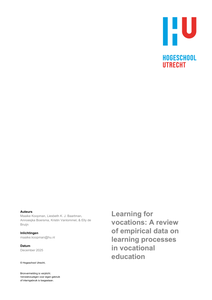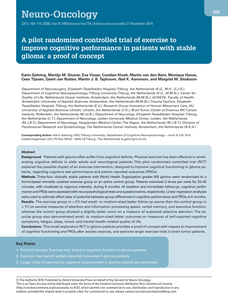In this paper, we report on the initial results of an explorative study that aims to investigate the occurrence of cognitive biases when designers use generative AI in the ideation phase of a creative design process. When observing current AI models utilised as creative design tools, potential negative impacts on creativity can be identified, namely deepening already existing cognitive biases but also introducing new ones that might not have been present before. Within our study, we analysed the emergence of several cognitive biases and the possible appearance of a negative synergy when designers use generative AI tools in a creative ideation process. Additionally, we identified a new potential bias that emerges from interacting with AI tools, namely prompt bias.
DOCUMENT

This article reports on a literature review on empirical research investigating learning for vocations in the context of vocational education. We included 36 studies in which learning for vocations is empirically studied. Learning for vocations is characterised based upon prevalent research traditions in the field and framed from the perspective of vocational education and organised learning practices. This framing and characterisation directed the search terms for the review. Results show empirical data on vocational learning and illustrate how learning processes for the functions of vocational education - vocational identity development, development of a vocational repertoire of actions, and vocational knowledge development - actually take place. The review further shows that, empirical illustrations of learning processes that occur in the context of vocational education and organised learning practices are relatively scarce. The findings can be typified in relation to our theoretical framework in terms of three learning processes, that is learning as a process of (a) belonging, becoming, and being, (b) recontextualization, and (c) negotiation of meaning and sense-making. We argue that more empirical research should be carried out, using the functions of vocational education and the three learning processes to better understand vocational learning.
DOCUMENT

From the article: Abstract Over the last decades, philosophers and cognitive scientists have argued that the brain constitutes only one of several contributing factors to cognition, the other factors being the body and the world. This position we refer to as Embodied Embedded Cognition (EEC). The main purpose of this paper is to consider what EEC implies for the task interpretation of the control system. We argue that the traditional view of the control system as involved in planning and decision making based on beliefs about the world runs into the problem of computational intractability. EEC views the control system as relying heavily on the naturally evolved fit between organism and environment. A ‘lazy’ control structure could be ‘ignorantly successful’ in a ‘user friendly’ world, by facilitating the transitory creation of a flexible and integrated set of behavioral layers that are constitutive of ongoing behavior. We close by discussing the types of questions this could imply for empirical research in cognitive neuroscience and robotics.
LINK
Stakeholders and in particular customers are an important source for business model innovation. Especially for sustainable business models, stakeholder integration may radically change the business logic and help to revise the business model. In this process cognition plays a central role, challenging basic assumptions and changing the dominant logic. In this paper we explore how interactions with the network contribute to making a cognitive shift in development of a sustainable business model. We build on three cases and closely look at the commercialisation stage in which a change of cognition and redesign of the business model take place. Our findings show that network interaction changes the dominant logic in business model innovation in two ways: by triggering a cognitive shift and by contributing to business model redesign. Our main contribution is the conceptualization of three interrelated shaping processes: market approach shaping, product/service offering shaping and credibility shaping. They provide a fine-grained perspective on value creation through collaborative networks and add to the business model literature by providing a framework to study the role of networks and cognition in business model innovation. For practitioners the shaping processes may support business model redesign and building relationships to advance commercialisation of sustainability-oriented innovations.
DOCUMENT

Abstract Background: Patients with glioma often suffer from cognitive deficits. Physical exercise has been effective in ameliorating cognitive deficits in older adults and neurological patients. This pilot randomized controlled trial (RCT) explored the possible impact of an exercise intervention, designed to improve cognitive functioning in glioma patients, regarding cognitive test performance and patient-reported outcomes (PROs). Methods: Thirty-four clinically stable patients with World Health Organization grades II/III glioma were randomized to a home-based remotely coached exercise group or an active control group. Patients exercised 3 times per week for 20-45 minutes, with moderate to vigorous intensity, during 6 months. At baseline and immediate follow-up, cognitive performance and PROs were assessed with neuropsychological tests and questionnaires, respectively. Linear regression analyses were used to estimate effect sizes of potential between-group differences in cognitive performance and PROs at 6 months. Results: The exercise group (n = 21) had small- to medium-sized better follow-up scores than the control group (n = 11) on several measures of attention and information processing speed, verbal memory, and executive function, whereas the control group showed a slightly better score on a measure of sustained selective attention. The exercise group also demonstrated small- to medium-sized better outcomes on measures of self-reported cognitive symptoms, fatigue, sleep, mood, and mental health-related quality of life. Conclusions: This small exploratory RCT in glioma patients provides a proof of concept with respect to improvement of cognitive functioning and PROs after aerobic exercise, and warrants larger exercise trials in brain tumor patients.
DOCUMENT

Dutch prevocational secondary schools are reforming their educational programmes to make them more competence-based. This reform has substantial implications for the roles played by teachers. Yet, little empirical research has been conducted on teachers' processes of competence development in vocational settings. This study explores teachers' individual action theories regarding the introduction of competence-based prevocational secondary education. The cognitive apprenticeship model provides a conceptual framework for addressing this issue. The research questions addressed here are: How do teachers value elements of the cognitive apprenticeship model in designing and delivering competence-based prevocational secondary education?, and, What individual action theories do teachers have regarding competence-based prevocational secondary education? The study was designed in two phases. In the qualitative phase, interviews and concept map techniques were used, while the quantitative phase employed a questionnaire. Teachers valued elements of the cognitive apprenticeship model differently, and suggested two additional features: a custommade educational approach and the professionalisation of teachers.
DOCUMENT
BACKGROUND: Differentiating mild cognitive impairment (MCI) from dementia is important, as treatment options differ. There are few short (<5 min) but accurate screening tools that discriminate between MCI, normal cognition (NC) and dementia, in the Dutch language. The Quick Mild Cognitive Impairment (Qmci) screen is sensitive and specific in differentiating MCI from NC and mild dementia. Given this, we adapted the Qmci for use in Dutch-language countries and validated the Dutch version, the Qmci-D, against the Dutch translation of the Standardised Mini-Mental State Examination (SMMSE-D).METHOD: The Qmci was translated into Dutch with a combined qualitative and quantitative approach. In all, 90 participants were recruited from a hospital geriatric clinic (25 with dementia, 30 with MCI, 35 with NC). The Qmci-D and SMMSE-D were administered sequentially but randomly by the same trained rater, blind to the diagnosis.RESULTS: The Qmci-D was more sensitive than the SMMSE-D in discriminating MCI from dementia, with a significant difference in the area under the curve (AUC), 0.73 compared to 0.60 (p = 0.024), respectively, and in discriminating dementia from NC, with an AUC of 0.95 compared to 0.89 (p = 0.006). Both screening instruments discriminated MCI from NC with an AUC of 0.86 (Qmci-D) and 0.84 (SMMSE-D).CONCLUSION: The Qmci-D shows similar,(good) accuracy as the SMMSE-D in separating NC from MCI; greater,(albeit fair), accuracy differentiating MCI from dementia, and significantly greater accuracy in separating dementia from NC. Given its brevity and ease of administration, the Qmci-D seems a useful cognitive screen in a Dutch population. Further study with a suitably powered sample against more sensitive screens is now required.
DOCUMENT

The event-related potential (ERP) approach has provided a wealth of fine-grained information about the time course and the neural basis of cognitive processing events. However, in the 1980s and 1990s, an increasing number of researchers began to realize that an ERP only represents a certain part of the event-related electroencephalographic (EEG) signal. This chapter focuses on another aspect of event-related EEG activity: oscillatory EEG activity. There exists a meaningful relationship between oscillatory neuronal dynamics, on the one hand, and a wide range of cognitive processes, on the other hand. Given that the analysis of oscillatory dynamics extracts information from the EEG/magnetoencephalographic (EEG/MEG) signal that is largely lost with the traditional time-locked averaging of single trials used in the ERP approach, studying the dynamic oscillatory patterns in the EEG/MEG is at least a useful addition to the traditional ERP approach.
DOCUMENT
To model individuals' experience of urban spaces, this study integrates knowledge from environmental psychology and artificial intelligence to propose a framework for individuals' perceptions and emotion by incorporating individual characteristics and cognitive appraisal together with environment attributes as determinants. A path model is employed to capture how the four perceptions of environmental qualities (safety, liveliness, comfort, and legibility) and three dimensions of emotion (pleasure, arousal, dominance) are influenced by individual characteristics and cognitive appraisal using data collected in an online virtual reality experiment with 237 participants. Results show that emotional pleasure is more directly influenced by environmental attributes while arousal and dominance are closely related to a person's current mood and personality. Perceptions of environmental qualities do have mediating effects in emotion generation, but contribute differently to the three dimensions of emotion. Cognitive appraisal variables directly influence emotion generation, with ideal values always having positive effects and expected values always negative effects. The findings can help capture the dynamic process of emotional experiences between diverse individuals and may support experience-centered simulation and prediction.
LINK
This study describes the socio-cognitive dynamics of collaborative online knowledge-building discourse among Dutch Master of Education students from the perspective of openness. A socio-cognitive openness framework consisting of four social and four cognitive components was used to analyze contributions to online collective knowledge building processes in two Knowledge Forum® databases. Analysis revealed that the contributions express a moderate level of openness, with higher social than cognitive openness. Three cognitive indicators of openness were positively associated with follow-up, while the social indicators of openness appeared to have no bearings on follow-up. Findings also suggested that teachers’ contributions were more social in nature and had less follow-up compared to students’ contributions. From the perspective of openness, the discourse acts of building knowledge and expressing uncertainty appear to be key in keeping knowledge building discourse going, in particular through linking new knowledge claims to previous claims and simultaneously inviting others to refine the contributed claim.
LINK